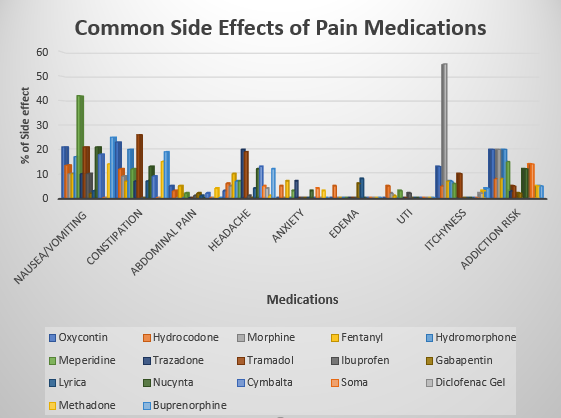Pain relief medications can be a lifesaver when it comes to managing discomfort and getting relief from various types of pain. However, like any medication, they can come with their fair share of side effects. So, what are the side effects of pain relief medications? Well, buckle up, because we’re about to delve into the world of potential downsides that these medications may bring.
When it comes to pain relief medications, it’s important to remember that they can affect individuals differently. While some people may experience minimal side effects or none at all, others may have a more pronounced reaction. It’s always a good idea to consult with your healthcare provider or pharmacist to understand the possible side effects specific to the medication you’re taking. Nonetheless, let’s explore some common side effects that may occur with pain relief medications, giving you a better understanding of what to expect.

Understanding the Side Effects of Pain Relief Medications
Pain relief medications are commonly used to alleviate various types of pain, from mild to severe. While these medications can provide much-needed relief, it’s important to be aware of their potential side effects. Understanding the possible side effects can help you make informed decisions about your pain management and minimize any potential risks.
1. Gastrointestinal Issues
Pain relief medications, such as nonsteroidal anti-inflammatory drugs (NSAIDs) and opioids, can cause gastrointestinal issues. NSAIDs, like ibuprofen and aspirin, may lead to stomach ulcers, heartburn, and upset stomach. Opioids, on the other hand, can cause constipation, nausea, and vomiting. It’s essential to take these medications with food or as directed by your healthcare provider to reduce the risk of gastrointestinal side effects.
Gastrointestinal side effects can vary from person to person. Some individuals may experience mild discomfort, while others may develop more severe complications. If you notice persistent gastrointestinal issues while taking pain relief medications, it’s crucial to consult your doctor for further evaluation and potential alternative options.
1.1 Tips to Minimize Gastrointestinal Side Effects
If you’re prone to gastrointestinal issues or want to minimize the risk of side effects, there are several strategies you can try:
1. Take pain relief medications with food or milk to reduce stomach irritation.
2. Avoid consuming alcohol while taking these medications as it can worsen gastrointestinal symptoms.
3. Consider using alternative pain relief methods, such as physical therapy or acupuncture, to reduce the need for medication.
2. Drowsiness and Dizziness
Certain pain relief medications, particularly opioids, can cause drowsiness and dizziness. These side effects can impair your ability to drive or operate machinery safely. It’s essential to be cautious when taking these medications and avoid activities that require full alertness until you understand how the medication affects you personally.
2.1 Coping with Drowsiness and Dizziness
If you experience drowsiness or dizziness while taking pain relief medications, consider the following tips:
1. Avoid driving or engaging in activities that require concentration until you know how the medication affects you.
2. Talk to your doctor about adjusting the dosage or trying alternative pain relief options if drowsiness or dizziness becomes a significant concern.
3. Take the medication before bed if drowsiness is a common side effect, so it doesn’t interfere with your daily activities.
3. Dependency and Addiction
Opioid pain relief medications carry a risk of dependency and addiction. Prolonged use or misuse of opioids can lead to physical and psychological dependence, making it challenging to stop taking the medication without experiencing withdrawal symptoms. It’s crucial to use opioids strictly as prescribed and under the guidance of a healthcare professional.
3.1 Recognizing and Addressing Dependency and Addiction
If you’re concerned about the potential for dependency or addiction to pain relief medications, consider the following steps:
1. Communicate openly with your healthcare provider about your concerns and any changes in your medication needs.
2. Follow your doctor’s instructions carefully, including tapering off the medication if necessary.
3. Seek support from a healthcare professional or support groups specializing in addiction and pain management.
4. Allergic Reactions
In rare cases, individuals may experience allergic reactions to pain relief medications. Symptoms can range from mild skin rashes to severe anaphylaxis, a life-threatening allergic response. If you notice any signs of an allergic reaction, such as difficulty breathing, swelling, or hives, seek immediate medical attention.
4.1 Understanding and Managing Allergic Reactions
To minimize the risk of allergic reactions, consider the following precautions:
1. Inform your healthcare provider about any known allergies or previous adverse reactions to medications.
2. Start with a low dosage when initiating a new pain relief medication to monitor for any allergic responses.
3. If you experience any concerning symptoms, stop taking the medication and seek medical help promptly.
5. Other Potential Side Effects
In addition to the mentioned side effects, pain relief medications can have other potential effects on the body. These may include changes in blood pressure, kidney or liver damage, and interactions with other medications. It’s crucial to discuss any concerns or questions about potential side effects with your healthcare provider.
5.1 Regular Monitoring and Communication with Your Healthcare Provider
To ensure your safety and well-being while taking pain relief medications, consider the following:
1. Attend regular check-ups with your healthcare provider to monitor your medication’s effectiveness and assess any potential side effects.
2. Keep an updated list of all medications you’re taking and share it with your healthcare provider to avoid any potential interactions.
3. Report any new or worsening symptoms to your healthcare provider promptly.
Remember, the side effects of pain relief medications can vary among individuals. It’s important to have open communication with your healthcare provider and work together to find the most suitable pain management approach for your specific needs. By staying informed and proactive, you can make informed decisions about your pain relief while minimizing potential side effects.
Key Takeaways: What are the side effects of pain relief medications?
- Pain relief medications can cause drowsiness and dizziness.
- Some pain medications may lead to constipation or upset stomach.
- Allergic reactions, such as rashes or difficulty breathing, can occur.
- Pain relief drugs may increase the risk of kidney or liver damage.
- Long-term use of pain medications can lead to dependence or addiction.
Frequently Asked Questions
What are the potential side effects of pain relief medications?
Pain relief medications, such as nonsteroidal anti-inflammatory drugs (NSAIDs) and opioids, can provide much-needed relief from discomfort. However, like any medication, they can also come with potential side effects. It’s important to be aware of these side effects so that you can make an informed decision about your pain management.
One common side effect of NSAIDs, which include aspirin and ibuprofen, is gastrointestinal discomfort. These medications can irritate the lining of the stomach and can lead to symptoms such as heartburn, nausea, and even ulcers with long-term use. NSAIDs can also affect kidney function, so it’s important to use them cautiously if you have pre-existing kidney problems.
Opioids, on the other hand, can cause side effects such as drowsiness, constipation, and respiratory depression. These medications have a higher risk of addiction and dependence, so they should be used under the guidance of a healthcare professional. Additionally, opioids can impair cognitive function and motor skills, so it’s important to avoid activities that require concentration or coordination while taking them.
Are there any serious side effects associated with pain relief medications?
While pain relief medications can be effective, they can also have serious side effects that require immediate medical attention. For example, NSAIDs can increase the risk of cardiovascular events, such as heart attack and stroke, especially when taken in high doses or for a prolonged period of time. If you experience symptoms such as chest pain, shortness of breath, or sudden weakness, it’s important to seek medical help immediately.
Opioids, on the other hand, can cause life-threatening respiratory depression, especially when taken in high doses or combined with other medications that suppress the central nervous system. Signs of respiratory depression include shallow breathing, slowed heart rate, and confusion. If you or someone you know experiences these symptoms, it’s crucial to call emergency services right away.
It’s important to note that these serious side effects are relatively rare, but it’s still essential to be aware of them and seek medical attention if needed. Always follow the recommended dosage and consult with your healthcare provider if you have any concerns or experience unusual symptoms while taking pain relief medications.
Can pain relief medications cause allergic reactions?
Yes, pain relief medications can potentially cause allergic reactions in some individuals. Allergies to NSAIDs, such as aspirin and ibuprofen, are relatively common. Symptoms of an allergic reaction can range from mild to severe and may include hives, itching, swelling, difficulty breathing, and even anaphylaxis, a life-threatening allergic reaction. If you experience any of these symptoms after taking pain relief medications, it’s important to seek immediate medical attention.
It’s also worth noting that individuals with a known allergy to one type of pain relief medication may be more likely to develop allergies to other medications in the same class. If you have experienced an allergic reaction to a specific medication in the past, be sure to inform your healthcare provider to avoid potential complications.
Do pain relief medications have any interactions with other medications?
Yes, pain relief medications can interact with other medications, potentially leading to adverse effects. For example, NSAIDs can interact with certain blood thinners, such as warfarin, increasing the risk of bleeding. They can also interfere with the effectiveness of certain blood pressure medications, such as ACE inhibitors and diuretics. It’s important to inform your healthcare provider about all the medications you are taking, including over-the-counter drugs and supplements, to avoid potential interactions.
Opioids, on the other hand, can have interactions with other medications that depress the central nervous system, such as benzodiazepines and sedatives. Combining these medications can increase the risk of respiratory depression and other serious side effects. Always inform your healthcare provider about all the medications you are taking to ensure safe and effective pain management.
Are there any long-term side effects of pain relief medications?
Long-term use of pain relief medications, especially NSAIDs, can have potential long-term side effects. For example, prolonged use of NSAIDs can increase the risk of gastrointestinal complications, such as stomach ulcers and bleeding. These medications can also affect kidney function, leading to kidney damage or even failure with long-term use. It’s important to use NSAIDs as directed and to consult with your healthcare provider if you need long-term pain management.
Opioids, on the other hand, have a higher risk of addiction and dependence with long-term use. Continued use of opioids can lead to physical and psychological dependence, making it difficult to stop using these medications without experiencing withdrawal symptoms. It’s important to work closely with your healthcare provider to develop a plan for safe and effective pain management, especially if you require long-term opioid therapy.
Long term use of painkiller can be harmful | How painkillers impact the body | PCM
Final Thoughts on the Side Effects of Pain Relief Medications
After exploring the topic of pain relief medications and their potential side effects, it’s clear that these medications can bring both relief and potential risks. While they are designed to alleviate discomfort and improve quality of life, it’s important to be aware of the potential side effects that can accompany their use.
It’s crucial to remember that not everyone will experience the same side effects, and some individuals may not experience any at all. However, common side effects of pain relief medications can include nausea, dizziness, drowsiness, constipation, and even allergic reactions. It’s essential to consult with a healthcare professional before starting any new medication, as they can provide guidance on the appropriate dosage and potential side effects based on your individual circumstances.
In conclusion, while pain relief medications can offer much-needed relief, it’s important to weigh the benefits against the potential side effects. By staying informed, working closely with healthcare professionals, and following proper dosage instructions, you can make informed decisions about pain management and minimize the risks associated with these medications. Remember, your health and well-being are always the top priority.


